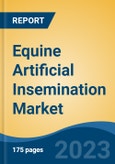Speak directly to the analyst to clarify any post sales queries you may have.
10% Free customizationThis report comes with 10% free customization, enabling you to add data that meets your specific business needs.
Key Market Drivers:
Genetic Improvement in Equine Traits
The equine breeding industry is undergoing a significant shift, driven by the pursuit of superior genetic traits in horses. This quest for genetic excellence has accelerated the growth of the Global Equine Artificial Insemination (AI) Market as breeders increasingly rely on advanced reproductive technologies to improve and refine the genetic composition of their horses. Artificial insemination offers several advantages over traditional mating methods, including access to genetic material from top sires worldwide, which breaks geographical barriers and diversifies the gene pool. This technology allows breeders to selectively pair stallions with desirable traits - such as speed, endurance, agility, and temperament - to produce offspring suited for various disciplines like racing, show jumping, dressage, and workhorse functions.Additionally, AI helps preserve genetic diversity within equine populations, minimizing the risks associated with inbreeding by introducing fresh genetic material. The technology also accelerates genetic progress by enabling the production of multiple offspring from a single stallion in one breeding season, thus enhancing the breed's overall quality and performance.
The demand for high-quality, genetically superior horses is rising, fueled by competitive sports, leisure riding, and other equine-related activities. As breeders aim to meet these market demands, artificial insemination has become a vital tool in achieving their goals. For instance, the equine industry in the United Kingdom plays a significant role in the economy, with substantial spending on breeding, training, and recreational activities. The Department for Environment, Food & Rural Affairs (DEFRA) regulates equine semen collection and storage, ensuring compliance with rigorous standards to safeguard the health and quality of the equine population.
Key Market Challenges:
Regulatory Compliance: A Complex Landscape
A primary challenge in the equine artificial insemination market is navigating the complex and varied regulatory landscape across different countries and regions. Each jurisdiction has its own set of rules governing equine breeding practices, including the use of artificial insemination. Ensuring compliance with these regulations can be a challenging task, particularly for breeders engaged in international trade. Understanding and adhering to these regulatory requirements is crucial to ensuring the legality and acceptance of artificially inseminated horses in various markets.Key Market Trends:
Precision Genetic Selection through Genomic Testing
The trend toward precision breeding is gaining traction within the equine industry. Genomic testing, which analyzes an individual horse's DNA to assess its genetic potential, is becoming more accessible and cost-effective. This technology allows breeders to make informed decisions about stallion and mare pairings, optimizing the likelihood of producing offspring with desirable traits. As genomic testing becomes more widely adopted, it is expected to lead to even more selective breeding practices, fostering the creation of superior equine bloodlines.Key Market Players
- IMV Technologies SADIR
- Stallion A I Services Ltd
- Zoetis Inc
- Neogen Corp
- Zerlotti Genetics Ltd
- Erc S.r.o.
- CVS UK Ltd
- HOFFMAN A.I. BREEDERS INC.
- Continental Genetics, LLC
- Minitüb GmbH
Report Scope:
In this report, the Global Equine Artificial Insemination Market has been segmented into the following categories, in addition to the industry trends which have also been detailed below:Equine Artificial Insemination Market, By Solution:
- Equipment & Consumables
- Semen
- Normal Semen
- Sexed Semen
- Services
Equine Artificial Insemination Market, By Equine Type:
- Sports/Racing
- Recreation
- Others
Equine Artificial Insemination Market, By Distribution Channel:
- Private
- Public
Equine Artificial Insemination Market, By Region:
- North America
- United States
- Canada
- Mexico
- Europe
- Germany
- United Kingdom
- France
- Italy
- Spain
- Asia-Pacific
- China
- Japan
- India
- Australia
- South Korea
- South America
- Brazil
- Argentina
- Colombia
- Middle East & Africa
- South Africa
- Saudi Arabia
- UAE
Competitive Landscape
Company Profiles: Detailed analysis of the major companies present in the Global Equine Artificial Insemination Market.Available Customizations:
With the given market data, the publisher offers customizations according to a company's specific needs. The following customization options are available for the report.Company Information
- Detailed analysis and profiling of additional market players (up to five).
This product will be delivered within 1-3 business days.
Table of Contents
Companies Mentioned
- IMV Technologies SADIR
- Stallion A I Services Ltd
- Zoetis Inc
- Neogen Corp
- Zerlotti Genetics Ltd
- Erc S.r.o.
- CVS UK Ltd
- HOFFMAN A.I. BREEDERS INC.
- Continental Genetics, LLC
- Minitüb GmbH
Table Information
| Report Attribute | Details |
|---|---|
| No. of Pages | 182 |
| Published | April 2025 |
| Forecast Period | 2024 - 2030 |
| Estimated Market Value ( USD | $ 658.06 Million |
| Forecasted Market Value ( USD | $ 923.24 Million |
| Compound Annual Growth Rate | 5.7% |
| Regions Covered | Global |
| No. of Companies Mentioned | 10 |









